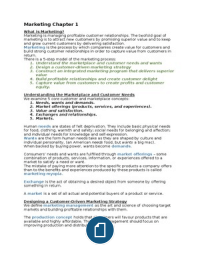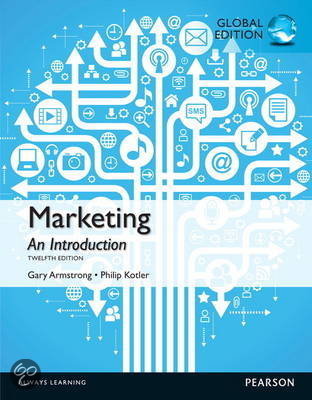Marketing Chapter 1
What is Marketing?
Marketing is managing profitable customer relationships. The twofold goal of
marketing is to attract new customers by promising superior value and to keep
and grow current customers by delivering satisfaction.
Marketing is the process by which companies create value for customers and
build strong customer relationships in order to capture value from customers in
return.
There is a 5-step model of the marketing process:
1. Understand the marketplace and customer needs and wants
2. Design a customer-driven marketing strategy
3. Construct an integrated marketing program that delivers superior
value
4. Build profitable relationships and create customer delight
5. Capture value from customers to create profits and customer
equity.
Understanding the Marketplace and Customer Needs
We examine 5 core customer and marketplace concepts:
1. Needs, wants and demands.
2. Market offerings (products, services, and experiences).
3. Value and satisfaction.
4. Exchanges and relationships.
5. Markets.
Human needs are states of felt deprivation. They include basic physical needs
for food, clothing, warmth and safety; social needs for belonging and affection;
and individual needs for knowledge and self-expression.
Wants are the form human needs take as they are shaped by culture and
individual personality, (an American needs food, but wants a big mac).
When backed by buying power, wants become demands.
Consumers’ needs and wants are fulfilled through market offerings – some
combination of products, services, information, or experiences offered to a
market to satisfy a need or want.
The mistake of paying more attention to the specific products a company offers
than to the benefits and experiences produced by these products is called
marketing myopia.
Exchange is the act of obtaining a desired object from someone by offering
something in return.
A market is a set of all actual and potential buyers of a product or service.
Designing a Customer-Driven Marketing Strategy
We define marketing management as the art and science of choosing target
markets and building profitable relationships with them.
The production concept holds that consumers will favour products that are
available and highly affordable. Therefore, management should focus on
improving production and distribution efficiency.
, The product concept is the idea that consumers will favour products that offer
the most in quality, performance, and innovative features. Under this concept,
marketing strategy focuses on making continuous product improvements.
Many companies follow the selling concept, which holds that consumers will not
buy enough of the firm’s products unless it undertakes a large-scale selling and
promotion effort.
The marketing concept holds that achieving organizational goals depends on
knowing the needs and wants to target markets and delivering the desired
satisfactions better than competitors do.
The societal marketing concept is the idea that a company’s marketing
decisions should consider consumers’ wants, the company’s requirements,
consumer’ long-run interests, and society’s long-run interests. It questions
whether the pure marketing concept overlooks possible conflicts between
consumer short-run wants and consumer long-run welfare.
Preparing an Integrated Marketing Plan and Program
Customer relationship management is the overall process of building and
maintaining profitable customer relationships by delivering superior customer
value and satisfaction.
Customer-perceived value is the customer’s evaluation of the difference
between all the benefits and all the costs of a marketing offer relative to those of
competing offers.
Customer satisfaction depends on the product’s perceived performance
relative to a buyer’s expectations.
Customer-engagement marketing makes the brand a meaningful part of
consumers’ conversations and lives by fostering direct and continuous customer
involvement in shaping brand conversations, experiences, and community.
A growing form of customer-engagement marketing is consumer-generated
marketing, by which consumers themselves are playing a bigger role in shaping
their own brand experiences and those of others.
In addition to being good at customer relationship management, marketers must
also be good at partner relationship management – working closely with
others inside and outside the company to jointly bring more value to customers.
Capturing Value from Customers
Customer lifetime value is the value of the entire stream of purchases a
customer makes over a lifetime of patronage.
The share of customer is the portion of the customer’s purchasing that a
company gets in its product categories.
Customer equity is the total combined customer lifetime values of all of the
company’s current and potential customers.
The Changing Marketing Landscape
Digital and social media marketing involves using digital marketing tools
such as websites, social media, mobile apps and ads, online video, e-mail, and
blogs that engage consumers anywhere, at any time, via their digital devices.





